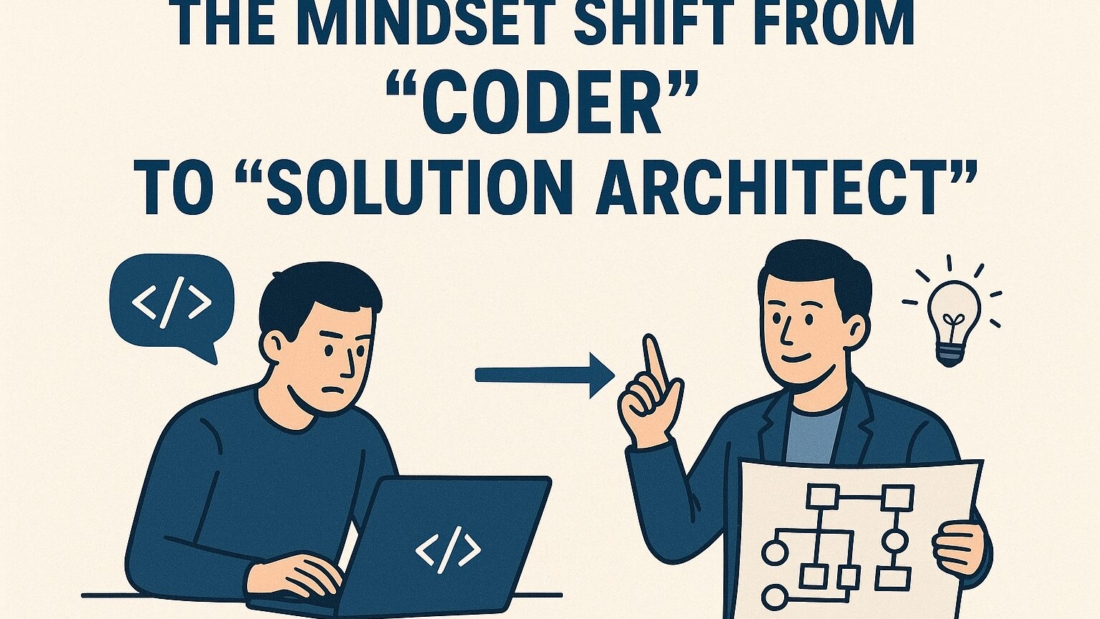In the early stages of a tech career, most professionals identify themselves as coders. The role is straightforward: write code, fix bugs, and implement the tasks assigned. But as you grow in the industry, you realize that coding is just one piece of a much bigger puzzle. The real value lies in designing solutions that address business problems effectively—and that’s where the transition from “coder” to “solution architect” begins.
This shift isn’t just about moving up the career ladder; it’s about adopting a new mindset. Let’s explore what this transformation means and how you can embrace it.
1. From Task Execution to Problem Solving
A coder’s world often revolves around instructions. You’re handed a Jira ticket, you write the code, and you move on to the next task. While this is essential for delivery, it limits your perspective to micro-level execution.
A solution architect, on the other hand, looks at the problem first. Instead of focusing on “what code needs to be written,” they ask:
What problem are we solving?
What’s the best way to design a solution that is scalable, secure, and cost-effective?
How will this solution integrate with existing systems and processes?
The mindset shift here is moving away from “How do I complete this task?” to “How do I design a system that solves the bigger problem?”
2. Thinking Beyond Code
Coders love code—that’s natural. But solution architects think beyond syntax. They analyze requirements, assess trade-offs, and select the right tools, frameworks, and platforms.
For example, instead of asking:
“Should I write this in Java or Python?”
An architect asks:
“What’s the best technology stack for long-term maintainability, performance, and business goals?”
This doesn’t mean coding becomes irrelevant. In fact, great solution architects often have a strong coding background. But they use coding as a tool, not the end goal.
3. Collaboration Over Isolation
Coders often work in silos, focusing on their individual tasks. A solution architect’s role, however, is inherently collaborative. They work closely with:
Product managers to understand business requirements
Developers to ensure feasibility and maintainability
Designers to align user experience with technical design
Stakeholders to evaluate costs, risks, and timelines
Becoming a solution architect requires strong communication skills. You need to translate technical jargon into business language and align technical solutions with organizational objectives.
4. Long-Term Vision vs. Short-Term Delivery
A coder may focus on meeting the next sprint goal, while a solution architect focuses on sustainability. They think about scalability, security, and future upgrades.
For example:
A coder might hardcode a feature because it works for now.
An architect considers whether the solution will still work with 10x more users, across different regions, with evolving compliance requirements.
This shift requires a mindset of systemic thinking—anticipating challenges before they occur and designing solutions that stand the test of time.
5. Embracing Trade-offs and Decision-Making
As a coder, you rarely face high-level trade-off decisions. But solution architects constantly deal with choices like:
Should we use cloud-native services or build on-premises?
Should we optimize for speed of delivery or robustness of architecture?
Is it better to buy an off-the-shelf solution or build custom software?
Every decision comes with trade-offs in terms of cost, performance, scalability, and maintainability. Developing the ability to weigh these trade-offs is a key part of the mindset shift.
6. Continuous Learning and Adaptability
Technology evolves fast. Coders need to keep up with languages and frameworks, but architects must keep up with entire ecosystems. This includes:
Cloud architectures (AWS, Azure, GCP)
Containerization and microservices
Security frameworks and compliance standards
Emerging trends like AI, edge computing, and serverless systems
The difference is scale: coders learn tools to execute, while architects learn concepts to strategize.
7. Owning Responsibility
Perhaps the most important mindset shift is responsibility. Coders are responsible for the quality of their code. Solution architects, however, are accountable for the entire system. If something goes wrong in performance, security, or integration, it often comes back to architectural decisions.
This ownership requires confidence, risk assessment, and the ability to defend your design choices. It’s not just about writing “good code”; it’s about ensuring the business runs smoothly because of your technical design.
How to Make the Transition
If you’re a coder aiming to become a solution architect, here are some practical steps:
Ask Bigger Questions – Don’t just accept tasks. Ask “why” and “what’s the larger goal?”
Learn System Design – Study architecture patterns, scalability principles, and real-world case studies.
Build Communication Skills – Practice explaining technical ideas in simple terms to non-technical stakeholders.
Study Trade-offs – Get comfortable with evaluating costs, risks, and performance trade-offs.
Mentor Others – Share your knowledge with teammates; teaching forces you to think like an architect.
Final Thoughts
The journey from “coder” to “solution architect” is not just a career upgrade—it’s a transformation in mindset. It’s about evolving from a task executor to a strategic problem solver who designs systems with long-term impact.
By embracing this shift, you don’t just grow as a technologist—you grow as a leader who bridges the gap between business needs and technical solutions. And in today’s fast-paced digital world, that’s where the real value lies.

